User Interface – The Toolbar
The toolbar displays all the available tools in Scalgo live. You can extract information from several tools at the same time by keeping the respective information boxes open. The tool you are actively using is colored blue in the toolbar.
How to enable/disable a tool
- Select the particular tool, and click on the map to view the function of the tool at a specific point.
- Disable the tool by closing the information boxes that are activated by the particular tool. The information boxes may either be a graph and/or Point Info. Read more about the information boxes by each tool.
Zoom

Zoom is the default tool that eases your movement across the map. Whenever you disable another tool, the zoom tool will be activated. There are four ways to zoom:
- Double-click where you want to zoom on the map
- Hold shift and draw the area you want to zoom by pressing the left button of the mouse
- Use the blue + and - buttons in the top right corner of the map.
- Use the scroll wheel of your mouse
Point Query

Point Query obtains information about the data of the enabled layers or analyses. If there is no enabled analysis or layer, the Info box will only show the coordinates of the chosen point (you can change the coordinate system under User in the toolbar).
To query a point on the map:
- Choose the layers and analyses you want to extract information from
- Select Point Query in the toolbar
- Click on the location you want to query
- An Info box in the bottom right corner provides information about the layers you have selected.
See the manual pages under "Analysis" for an explanation of the point query results for the different kinds of analysis.
Profile

The profile tool is used to study the elevation of cross sections of the terrain across multiple DEMs. To create a cross section:
- Select 'Profile' in the toolbar
- Click on the map and draw a path where you want to view a cross section. You can insert vertices by single-clicking. The info box continuously shows the length of the path.
- Double-click to end the path.
- Click and pull anywhere on path to adjust its location.
- Select an elevation layer in the dock. You can enable several elevation models when using the graph.
- Select 'show profile' in the measurement box, and the profile will show.
- You now have the following options:
- You can use the scroll-wheel on your mouse to zoom
- You can use the plus/minus buttons on the top to adjust the size of the profile window
- You can download the data by selecting the download button
 in the top bar. By default you will get Excel spreadsheet file, but you
can change the format in the account
dashboard.
in the top bar. By default you will get Excel spreadsheet file, but you
can change the format in the account
dashboard.
Note: when you are moving your mouse along the graph, the exact coordinates and elevation will be displayed underneath the graph. At the same time, a dot will move along the path on the map and correspond to where your mouse is on the graph.
Uniform scale
There are two different ways to view the profile, either by default scale or uniform scale. The scales differs in the Y-axis: The default scale has a Y-axis a little higher and lower than the elevation in the profile. In the uniform scale shows . Enable the uniform scale at the top of the graph.
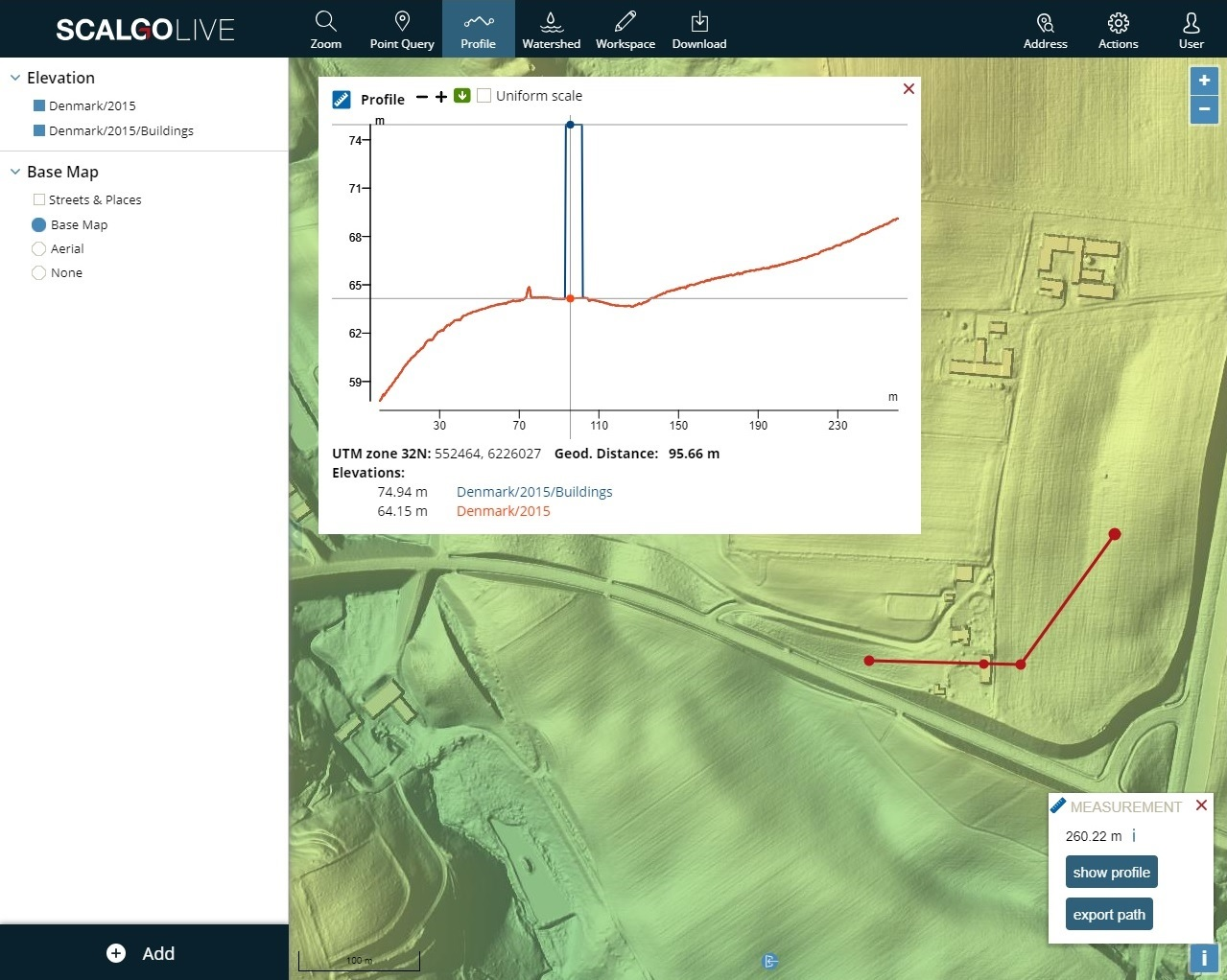
Freezing the profile
The elevation data displayed by the profile tool continuously follows the mouse position, so that you can quickly find points of interest. When you wish to copy and paste this data, or if you wish to make a screen shot, this is inconvenient. You can ask the profile tool to hold a given position by moving your mouse to the point of interest, right-clicking, and selecting Freeze position here from the context menu.
To go back to the dynamic display of elevation data, right-click again anywhere in the profile tool and select Unfreeze position.
Measuring gradients
You can ask the profile tool to display the gradient of the profile between two given points. Move the mouse to the starting point, right-click, and select Measure gradient from here from the context menu.
The table at the bottom of the profile tool will now be extended to show not only the elevation of the current point, but also the gradient with respect to the fixed black measuring point. The Distance line shows the horizontal distance (along the profile) between the current point and the measuring point in parenthesis.
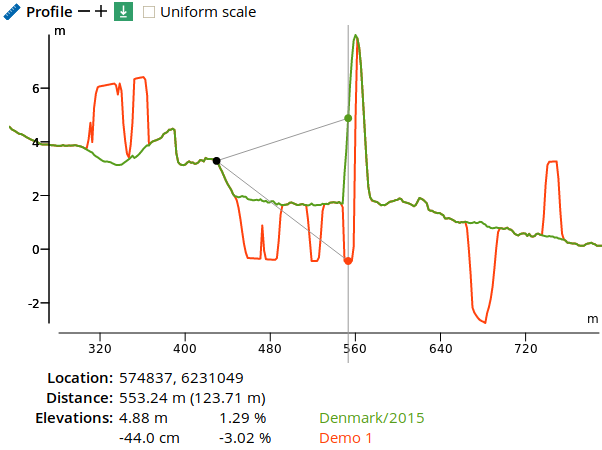
You can change the measuring point by right-clicking a new point and selecting Measure gradient from here again. You can end the display of gradients by right-clicking and selecting Stop measuring gradients.
Watershed

The watershed tool lets you click anywhere on the terrain and see the upstream area of that point (green) and the
downstream path from the point (red or dark blue).
- Select Watershed in the toolbar.
- Choose which analysis should be queried: Flash Flood Mapping, Depression-Free Flow, or a workspace analysis.
- Now click a point on the map to see its watershed.
Flash Flood Mapping
If you have chosen to use the Flash Flood
Map, the query illustrates the water flow of your selected point to the first disconnected river
network or to a depression large enough to hold your selected amount of rain water.
The map may look something like this:
The different areas illustrate the following:
- The green area is the watershed of the selected point.
- The red area illustrates the flooded area around the selected point for the given rain event.
- The blue lines and areas illustrate the downstream path from the selected point.
The different shades of blue indicate the water depth in an area - the darker the blue, the deeper the water. The downstream area will often flow to a watercourse, a river or the sea, but in some cases, it ends in e.g., a field - as seen on the map above in light blue.
In the example above, the light blue area is where the downstream area ends and where the river network disconnects. If you select the light blue area with the watershed tool, you will see that your previously selected area is part of the watershed of the light blue area.
Slider: Setting the rain event
Use the slider to set the rain event you want to investigate. When you increase the amount of rain, the watershed enlarges as more depressions fill up and overflow into the watershed.
Watershed info
When using the watershed tool on the Flash Flood Map you will get the following information:
- Upstream area: the size of the watershed.
- Volume: information about water volumes in the watershed.
- Depression storage: the amount of water stored in the watershed.
- Runoff: the amount of water that flows through the selected point as runoff at the given rain event.
- Infiltrated or drained: the amount of water that has infiltrated or drained into sewers. This is only shown for the Flash Flood Map when infiltration and drainage are enabled.
- Land cover/soil type: Information about the composition of the watershed into land cover and/or soil type classes (only available in some countries).
In general, the depression storage and runoff volume combined equal the volume of precipitation falling in the watershed.
Depression-Free Flow
When using the Depression-free flow layer, the map will automatically regard all depressions as ‘filled’ and therefore surface water will flow all the way to the sea. If you want to use the watershed tool with the Depression-free flow analysis, remember to select Depression-free flow in the drop down menu.
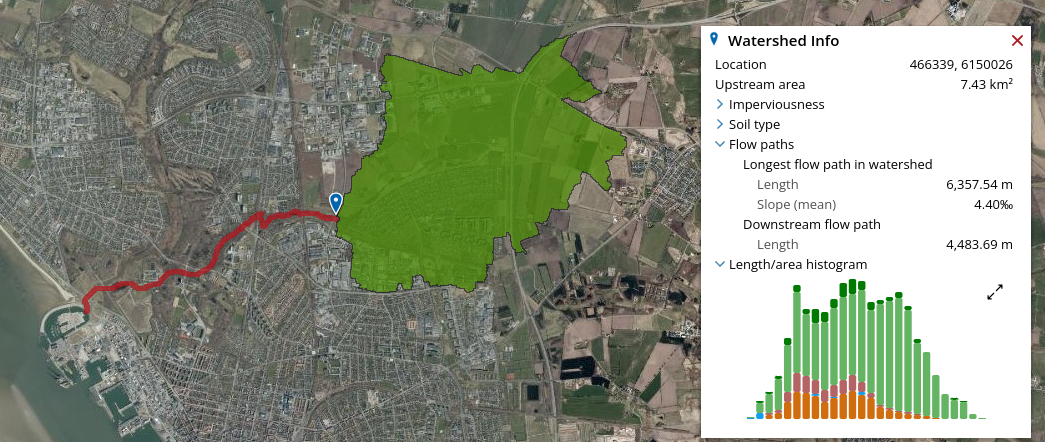
If you use flash flood mapping and set the rain event slider to very large number you will see that the
Depression-free flow and Flash Flood Mapping shows more or less the same picture. As all depressions are filled by rain, it is therefore
flowing all the way to the ocean. The two results may differ on flat areas, such as lakes.
Watershed info
When using the watershed tool on the Depression-free flow layer, you will get the following information:
- Location: The location of your selected point.
- Upstream Area: The size of the upstream area of the watershed.
- Land cover/soil type: Information about the composition of the watershed into land cover and/or soil type classes (only available in some countries).
- Paths: Information about the longest path and the downstream path:
- Longest upstream path: Shows you information about of the longest upstream path,
defined as
the longest flow path in the watershed. If you want to see this
path, you
can click the
-button to have it displayed on top of the watershed. You can also see the average slope of this path.
- Downstream path: Shows the length of the flow path from the selected point to the outlet.
This
path is displayed on the map by default, but you can use the
-button to hide it.
- Longest upstream path: Shows you information about of the longest upstream path,
defined as
the longest flow path in the watershed. If you want to see this
path, you
can click the
- Length/area histogram: The histogram of the length of the upstream paths to the selected point. Click the small histogram to enlarge it. See below for details.
Note that path lengths are calculated based on flow paths between individual neighboring grid cells (in 8 cardinal directions) in the elevation model. Paths measured on a grid like this will most likely be longer than if measured along e.g. river centerlines since the grid-based directions will "zig-zag" between the grid cells along the natural flow line.
Length/area histogram
The Length/area histogram is a way to understand how far water has to travel in the watershed before it reaches the selected point. For every point in the upstream area, we compute the length of the downstream path to the selected point. We split the total range of these lengths into buckets of equal size, and for each bucket we count how many points in the terrain fall within its length interval. This tells us how much of the total watershed area is within each bucket's interval interval.
We plot this information in a bar chart showing a bar per interval interval, with a line chart as overlay showing the accumulated area where the downstream paths are shorter than or lie within the corresponding intervals.
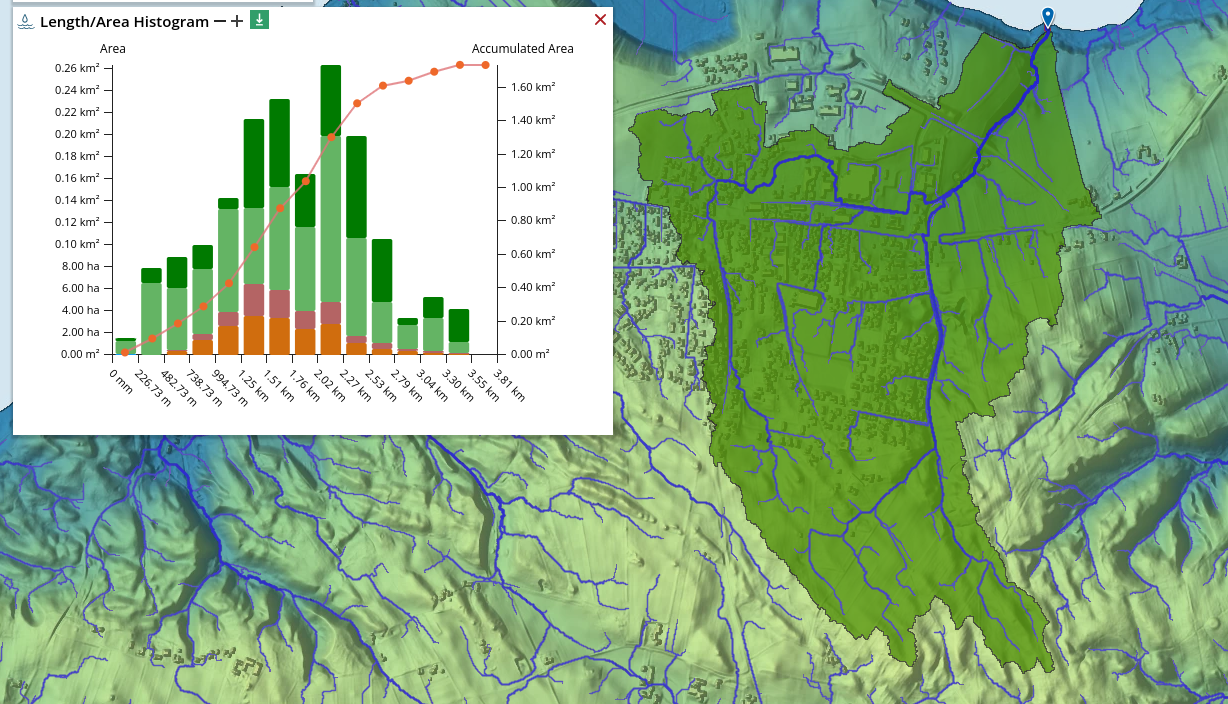
If you click one of the bars of the histogram, it will highlight the accumulated area where the length of the downstream path is smaller than the selected interval. Click again to disable the highlighting.
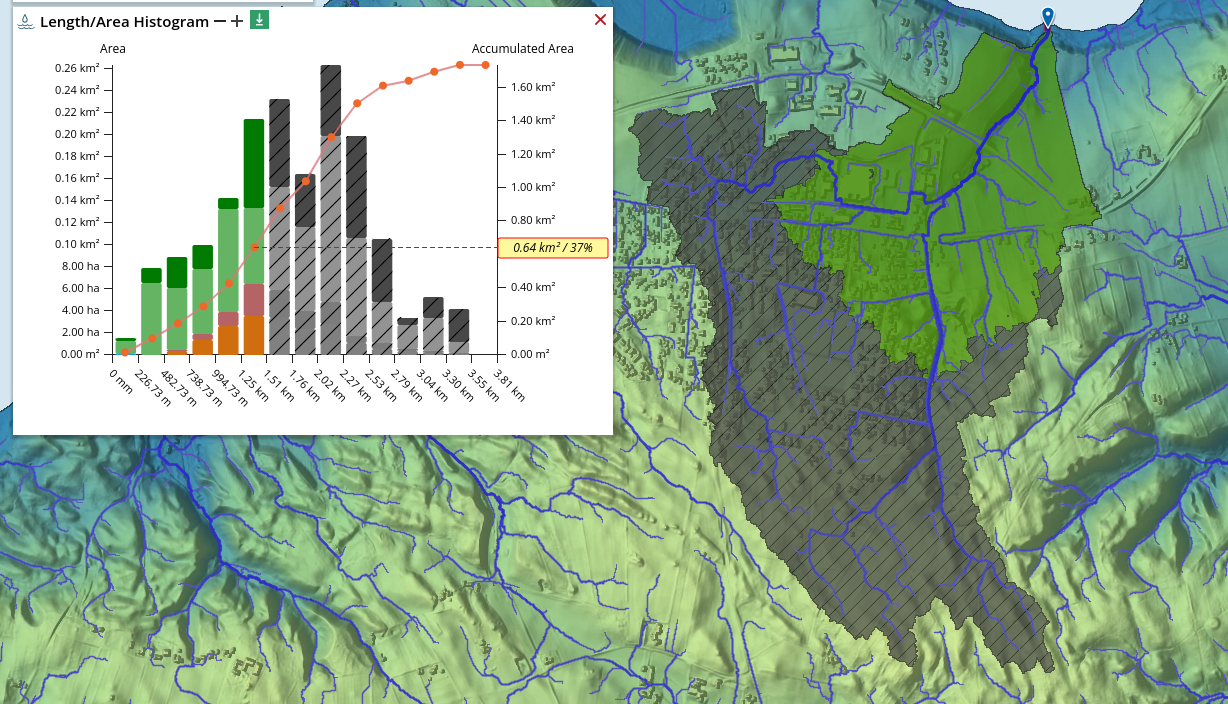
Watershed queries and stormwater networks
You can model stormwater systems/networks by combining subsurface structures in a workspace. A key feature of these stormwater networks is their interaction with the watershed tool that allows you to easily see how surface water enters your pipe networks. It does this by giving a different color the each of the subwatersheds defined by the inlets of your network upstream of the query point. By default, if you place a watershed query on a stormwater network component, you will get this view, but if you, however, actually were interested in the surface watershed of that same location, you can use the toggle in the watershed info dialog to switch between the two. See the figures below for an example of what this looks like.
The surface watershed is the "regular" watershed of the location on the elevation model you have queried and shows the watershed of the flow arriving to the surface at that location - as opposed to the watershed of the subsurface structure underneath the surface.

Watershed query with a stormwater system shown in subsurface mode shown the watershed of each inlet in a separate color.

The same query location in surface mode shows the surface watershed of the point, in this case - the downstream path from that point leads to the same retention basin nearby, but bypasses the network since it does not encounter an inlet.
When you export the results of a watershed query on a stormwater network, you get all the subcatchments/subwatersheds of each inlet alongside some interesting properties that are similar to the properties you get for regular watershed queries. This includes:
- Length of the longes flowpath in the subwatershed.
- Average slope of the longest flowpath
- The land cover/soil type distribution in the subwatershed (only available in some countries)
Note, at this time this information is only available if you export from the Depression-Free Flow analysis.

A watershed query for the area above loaded into QGIS for visualization.
Workspaces
Please consult the workspace section of the documentation to understand how to use workspaces.
Export
Please consult the exporting section of the documentation for the various ways in which you can bring data from Scalgo Live into reports, presentations, or other software tools you work with.
Address

Address enables you to search for a particular address.
- Select the button Address
- Type an address and press one of the options provided by the tool.
- The map will show the address you have typed in.
Alternatively, you can paste in the coordinates of a point (separated by a comma) in the currently selected coordinate system to zoom to the point right away.
Help

Help give you access to the manual, support and to our getting started guide
- Getting started directs you to our collection of getting started videos.
- Open Manual directs you to this manual
- Get Support directs you to our support page, where contact information is located in case the manual does not suffice.
User

User gives you the ability to:
- Choose theme; if you have access to more than one setup, e.g. both Denmark and Sweden.
- Determine which type of coordinates, you wish displayed in Point Info. The options are different depending on
your country.
- Access account settings. Here you will access account management and be able to:
- view and change user information
- view workspace information.
- Duplicate, share or extract terrain-edits from one or more workspaces
change password - View the users of your organisation
- See whether you have access to any add-ons
- Log out of SCALGO Live